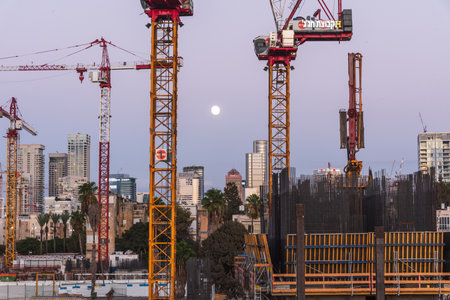Overview of the Build-to-Rent (BTR) Landscape in the UK
The Build-to-Rent (BTR) sector has rapidly emerged as a defining force within the UK property market, reshaping both urban skylines and the very fabric of renting culture. Traditionally dominated by private landlords and buy-to-let models, the British rental sector is now witnessing significant investment and innovation through purpose-built rental developments. This paradigm shift has been driven by evolving demographics, changing lifestyle aspirations, and increasing barriers to homeownership for younger generations. At its core, BTR responds to a clear demand: professionally managed, high-quality accommodation that places convenience, community, and flexibility at its heart. With renters’ expectations shifting towards amenity-rich living—think co-working spaces, fitness studios, and rooftop gardens—developers are responding with schemes designed to foster a sense of belonging while delivering long-term value. As we look ahead to 2025 and beyond, this sector’s growth is further fuelled by institutional investors seeking stable returns and local authorities eager to address housing shortages. The result is a dynamic landscape where BTR is not just filling gaps in supply but actively setting new standards for what it means to rent in modern Britain.
Key Locations Leading the BTR Surge
The Build-to-Rent (BTR) sector is transforming the UK’s property landscape, with certain cities and regions emerging as hotspots for forward-thinking investors. As the demand for professionally managed rental accommodation rises, these locations are demonstrating remarkable resilience and growth potential, setting them apart as leaders in the BTR movement through to 2025 and beyond.
UK Cities at the Forefront of BTR Investment
While London continues to command attention due to its scale and international appeal, several regional cities are now outperforming traditional markets both in terms of yield and tenant demand. The “Northern Powerhouse” cities—Manchester, Leeds, and Liverpool—have become synonymous with thriving BTR pipelines, driven by strong graduate retention rates, a vibrant job market, and ongoing regeneration schemes. Birmingham and Bristol also stand out, benefitting from connectivity upgrades such as HS2 and growing technology sectors that attract young professionals seeking high-quality rental living.
Comparative Overview: Key BTR Locations
| City/Region | BTR Pipeline Size (Units) | Key Drivers | Average Gross Yield (%) |
|---|---|---|---|
| London | 30,000+ | International workforce, strong rental demand, regeneration zones | 3.5–4.0% |
| Manchester | 12,000+ | Graduate retention, tech sector growth, city centre living | 5.0–6.0% |
| Birmingham | 8,500+ | HS2 connectivity, financial hub expansion, cultural amenities | 5.2–5.8% |
| Leeds | 7,200+ | Young demographic, university presence, urban renewal | 5.0–5.6% |
| Liverpool | 6,000+ | Regeneration projects, affordable entry points, student retention | 5.4–6.1% |
| Bristol | 5,300+ | Aerospace/tech industries, green credentials, lifestyle appeal | 4.8–5.3% |
What Sets These Locations Apart?
The success of these leading BTR locations is underpinned by a blend of robust local economies, ambitious infrastructure investment, and evolving lifestyle preferences amongst renters. For example, Manchester’s flourishing digital media scene fuels ongoing inward migration from across the UK and overseas; Birmingham’s Big City Plan has unleashed waves of redevelopment; while Bristol’s sustainability focus aligns perfectly with eco-conscious tenants.
This regional diversification reduces overreliance on London and presents investors with unique long-term growth opportunities based on local market fundamentals rather than speculative hype.
![]()
3. Trends Shaping the BTR Sector for 2025 and Beyond
The Build-to-Rent (BTR) sector in the UK continues to evolve at pace, driven by shifting tenant expectations, demographic changes, and broader urban regeneration agendas. As investors look ahead to 2025 and beyond, several key trends are set to define the market’s trajectory and underpin long-term value.
Design Evolution: Flexible Living for Modern Tenants
BTR developments are moving away from uniform layouts towards highly adaptable spaces that cater to a range of lifestyles. There is a clear emphasis on high-quality finishes, energy-efficient materials, and versatile communal areas that can serve as co-working hubs, wellness zones, or event spaces. In particular, pet-friendly design and private outdoor areas—be it balconies or shared gardens—are fast becoming non-negotiables for many renters across leading UK cities.
Amenity-Led Offerings: Raising the Bar on Convenience
The competitive edge for BTR schemes increasingly lies in their amenity packages. Residents now expect facilities such as state-of-the-art gyms, cinema rooms, parcel lockers, and 24/7 concierge services as standard. Schemes in emerging hotspots like Manchester, Birmingham, and Leeds are also piloting green initiatives—think rooftop allotments and bicycle repair stations—to appeal to environmentally conscious tenants. These amenities not only enhance day-to-day living but also support higher occupancy rates and tenant retention, strengthening long-term investor returns.
Technology Integration: The Smart Home Advantage
Smart technology is playing an ever-greater role in the BTR sector. Touchless entry systems, integrated app-based controls for heating and lighting, and advanced security features are being embedded from the outset. This digital-first approach streamlines building management while meeting residents’ expectations for seamless connectivity—a trend particularly pronounced among younger professionals gravitating towards city-centre living.
Professional Management: Delivering Consistent Quality
Unlike traditional private rental stock, BTR developments stand out for their dedicated on-site management teams. Proactive maintenance, transparent communication channels, and resident engagement programmes are now hallmarks of successful schemes. This professional oversight not only enhances tenant satisfaction but also minimises void periods and repairs costs over time, ultimately safeguarding investor yields.
Taken together, these trends signal a maturing sector that is well-positioned to deliver both stable rental income and capital appreciation over the long term. Investors seeking resilient opportunities should pay close attention to how leading UK locations are embracing these innovations—setting new benchmarks for quality and value within the rental market.
4. Regulatory and Policy Landscape
The regulatory and policy landscape is central to the trajectory of Build-to-Rent (BTR) developments across the UK, shaping both the opportunities and challenges for investors looking towards 2025 and beyond. Government policies, planning frameworks, and active local authority involvement are all instrumental in determining where and how BTR schemes can thrive.
National Policy Direction
The UK government has increasingly recognised the value of BTR as a means to address housing shortages and improve rental standards. Initiatives such as revisions to the National Planning Policy Framework (NPPF) specifically reference BTR, encouraging local authorities to allocate land for such schemes. Further, the government’s focus on brownfield regeneration and urban renewal aligns well with BTR investment objectives, particularly in city centres and commuter belts.
Local Authority Involvement
Local authorities play a pivotal role through their planning decisions, Section 106 agreements, and allocation of affordable housing quotas within BTR projects. There is notable variation in how councils interpret guidance and balance housing needs with viability for investors. This creates distinct regional trends in BTR delivery:
| Region | Planning Approach | BTR Impact |
|---|---|---|
| Greater London | Proactive BTR policy inclusion; flexible affordable provision | High concentration of BTR schemes, rapid growth |
| Manchester & Birmingham | Supportive frameworks; clear guidance for developers | Significant pipeline, attracting institutional investors |
| Smaller Cities & Towns | Emerging strategies; varied engagement levels | Growing interest, but inconsistent delivery pace |
Key Planning Frameworks Affecting BTR
BTR developers must navigate several layers of regulation:
- NPPF Guidance: Encourages recognition of BTR as a distinct asset class with unique planning considerations.
- Section 106 Agreements: Often require negotiation on affordable housing components, impacting scheme viability.
- Sustainability Standards: Increasing requirements for energy efficiency, biodiversity net gain, and resident wellbeing.
- Renters’ Reform Bill: Proposals to enhance tenant security and rights could influence operational models for BTR landlords.
The Outlook for Investors
An evolving policy environment means that successful BTR investment requires ongoing engagement with both national initiatives and local authority preferences. Locations where councils have adopted clear, supportive stances—such as London boroughs or forward-thinking northern cities—are likely to maintain a competitive edge. However, consistency across regions remains a challenge, making due diligence on regulatory context a critical step for long-term investment success in the UK’s BTR sector.
5. Investment Considerations and Market Outlook
For both UK-based and international investors, the build-to-rent (BTR) sector presents a compelling proposition. However, to navigate this evolving landscape successfully, careful assessment of several key factors is paramount. Below, we outline critical considerations and provide a forward-looking perspective on market growth as we move beyond 2025.
Key Assessment Criteria for BTR Investment
Location Fundamentals
Location remains a cornerstone of BTR investment success. Investors should scrutinise local employment hubs, transport connectivity, and proximity to universities or regeneration zones. Cities such as Manchester, Birmingham, and Leeds offer robust tenant demand driven by thriving economies and vibrant urban centres.
Demographic Trends and Tenant Demand
Understanding the shifting demographics is crucial. The growing number of young professionals, students, and downsizers seeking flexible rental options underpins resilient demand in many UK cities. International investors should look for locations where this demographic transition is most pronounced.
Operational Efficiency and Management Expertise
The long-term returns of BTR assets are heavily influenced by operational efficiency. Partnering with reputable management firms that prioritise tenant experience, sustainability measures, and technology integration will be key to maximising occupancy rates and rental yields.
Regulatory Environment
The regulatory framework in the UK is dynamic. Investors must remain attuned to changes in planning policy, building safety requirements, and evolving standards for energy efficiency—factors that can materially impact project viability and operational costs.
Market Outlook: Post-2025 Growth Prospects
The outlook for the UK BTR sector remains strongly positive as we look towards 2025 and beyond. Industry forecasts suggest continued expansion fuelled by persistent housing undersupply, shifting lifestyle preferences favouring renting over home ownership, and increased institutional capital targeting residential real estate. Regional cities are expected to see the fastest growth in new developments as affordability pressures in London push both renters and investors towards alternative markets.
A Resilient Long-Term Opportunity
In summary, while the BTR sector offers attractive opportunities for sustained income and capital appreciation, prudent due diligence is essential. By focusing on well-connected locations with strong tenant fundamentals, aligning with experienced operators, and staying agile amid regulatory shifts, investors can position themselves at the forefront of the UK’s evolving rental landscape well into the next decade.
6. Conclusion: The Future of Build-to-Rent in the UK
As we look beyond 2025, the build-to-rent (BTR) sector is poised to remain a cornerstone of the UK’s evolving property landscape. The surge in demand for high-quality, professionally managed rental accommodation continues to underpin strong investor confidence, especially in thriving regional cities like Manchester, Birmingham, and Leeds. These locations have demonstrated resilience and adaptability, making them prime candidates for sustained BTR growth. However, stakeholders must remain vigilant in navigating regulatory changes, planning challenges, and fluctuating economic conditions that could influence investment returns. Moreover, the focus on sustainability, community engagement, and tenant experience is set to intensify as renters’ expectations rise and ESG criteria become ever more central to institutional strategies. In summary, while the BTR market presents substantial opportunities for those who are proactive and well-informed, success will rely on a nuanced understanding of local dynamics and a long-term commitment to quality and innovation. The journey ahead promises both reward and complexity for investors and developers willing to engage with this dynamic asset class.


